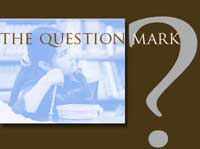In the Early Years
By Jamie McKenzie
About Author
 Very young children can wrestle with challenging questions and issues. Very young children can wrestle with challenging questions and issues.
While the activities may emphasize multi-sensory learning and play, four year old children can operate at the top of Bloom's Taxonomy - making smart choices (evaluation) and inventing good solutions (synthesis). It pays to start them early, build the foundations and establish the habits of mind that will sustain them through schooling into the adult years.
Thirty years ago I wondered just how early children could manage such challenging material, having read Jerome Bruner's assertion that even four year olds could handle difficult thinking if the tasks were framed properly. At the same time, others were claiming that such thinking must wait until children reached the age of 12 - according to their interpretation of Piaget.
Moving from theory into practice, I taught four year olds in Sunday school for several years and found that Jerome Bruner was correct. Framed properly, the very young can wrestle with challenging issues and be inventive.
What is a good friend? What color is the sky?
Four year olds are ready to explore important questions like "What is a good friend?" and "What color is the sky?" It is simply part of growing up.
They will explore such questions whether they have teachers or parents helping with the thinking or not, but good teachers and involved parents can nurture their sense of wonder, help them to sharpen their powers of observation and strengthen their capacity to think logically.
Children come to understand the traits of a good friend, the characteristics of a good cookie, and the nature of a sunset. As the ability to understand traits is an essential part of making smart choices, when we engage our four year olds in exploring these questions, we are laying the groundwork for the decision-making and problem-solving they must handle later in life.
Nurturing a Sense of Wonder
Rachel Carson, best known, perhaps for her important book Silent Spring, also wrote a wonderful book, A Sense of Wonder, in which she explored the importance of wonder to childhood and shared tales of expeditions and wanderings she conducted with her young nephew:
- If I had influence with the good fairy who is supposed to preside over the christening of all children, I should ask that her gift to each child in the world be a sense of wonder so indestructible that it would last throughout life as an unfailing antidote against the boredom and disenchantment of later life, the sterile preoccupation with things that are artificial, the alienation from the sources of our strength.
Page 54
| The Sense of Wonder by Rachel Carson was first published by Harper & Row in 1965. A wonderful new edition (Harper-Collins, ISBN 0-06-757520-X)) with fresh photographs by Nick Kelsh was published in 1998. It offers a vivid collection of words and images illustrating the allure of wonder.
Order The Sense of Wonder from Amazon.
|
-
- The years of early childhood are the time to prepare the soil. Once the emotions have been aroused - a sense of the beautiful, the excitement of the new and the unknown, a feeling of sympathy, pity, admiration or love - then we wish for knowledge about the object of our emotional response.
Once found it has lasting meaning.
It is more important to pave the way for the child to want to know than to put him on a diet of facts he is not ready to assimilate.
Page 56
If young ones can maintain a sense of wonder as they pass through early childhood into adolescence and early adulthood, that inclination may inspire much of their questioning. As they yearn to understand and make the best of life, a sense of wonder tilts their thinking forward. They grow bolder and stronger in their questioning, testing the edges and boundaries of conventional reasoning, pushing into new territory, demanding fresh truths and answers. They will not see school as a time to memorize time honored answers to multiple choice questions. They will refuse to participate in the “one more brick in the wall” rituals.
|

 Very young children can wrestle with challenging questions and issues.
Very young children can wrestle with challenging questions and issues.